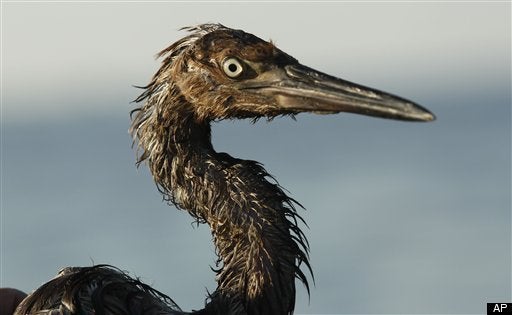
Although rarely considered, many human activities deprive wild animals of their life necessities by destroying or impoverishing their surroundings, causing suffering of individuals through displacement, stress, starvation, and diminished security. Yet, the notion that animal welfare applies to wildlife has escaped most people, including animal welfarists and conservationists alike.
In June 2010, Enbridge Inc. filed an application for its Northern Gateway Project with Canada's National Energy Board (NEB). The proposed project includes twin pipelines running 1,172 kilometers (727 miles) over the rugged and geologically unstable Rocky and Coast Mountains between a tar sands refinery hub near Edmonton, Alberta and a marine terminal near Kitimat, British Columbia. One of the lines would carry tar sands crude to Canada's north Pacific coast for export to energy-hungry Asian and American markets. The other would import highly toxic petroleum condensate. Supertankers, each carrying up to two million barrels of the world's dirtiest oil or condensate, would thread their way through precariously narrow channels to the open ocean while emitting tons of pollutants into the coastal environment.
The enormity and consequences of even a single spill affecting this large, remote, and ecologically sensitive area are simply too catastrophic to justify even a small risk of disaster. Simply, over time catastrophic oil and condensate spills on land and water are predictable. And from a hazard perspective, the pipelines, storage facilities and tankers are subject to the combined effects of simultaneous and converging natural disasters, including earthquakes, tsunamis, floods, wind events and forest fires.
To determine if the project is in the public interest and should be allowed to proceed, the NEB is conducting hearings to assess the economic, social, and environmental impacts of the proposed pipeline development. These are the supposed "three pillars of sustainable development," but absent among the pillars is any consideration for the welfare of wild animals affected by the construction, presence, operation, and maintenance of the pipeline, or by the shipping of oil by supertankers. By using the faulty three legs of the stool as a model for sustainable development and decision making, the NEB perpetuates the myth that the environment is something apart from the welfare of animals, humanity's economy, and our social well-being. Humanity is once again placed outside the environment and the welfare of other species is completely ignored.
The damage and deprivation to marine and terrestrial wildlife from catastrophic oil spills have already been extensive. For example, the effects of the Exxon Valdez disaster 22 years ago this month on wildlife populations in Alaska's Prince William Sound have been widespread and long lasting. Although the Exxon Valdez oil spill is indelible in our minds as one of the most environmentally destructive in history, it ranks only as the 53rd largest. Notably, its disproportionate impact relates to the ecological wealth of the west coast marine environment that was affected.
As an illustration of the incredible susceptibility of marine birds to oil, researchers estimated that 300,000 marine birds died in the immediate aftermath of the Exxon Valdez oil spill. Scientific studies have shown that Pacific herring and pigeon guillemot populations have failed to recover after more than 20 years. Still recovering are sea otters, killer whales, and other marine birds such as Barrow's goldeneyes and harlequin ducks. Sediments and intertidal communities are also contaminated and slowly recovering, including the clams and mussels that provide nourishment to so many maritime animals.
Although no oiled carcasses were recovered, two different populations of killer whales, both in Prince William Sound at the time of the spill, experienced dramatic declines. The fish-eating AB resident pod of killer whales lost 14 of its 36 members following the spill. A second population, the AT1 mammal-eating transients, were seen surfacing in the oil near the Exxon Valdez. Since then, the group has not successfully reproduced. Most likely, this unique killer whale population will go extinct.
According to the National Wildlife Federation, more than 8,000 birds, sea turtles, and marine mammals were found injured or dead in the six months following BP's Gulf of Mexico oil spill. The long-term damage caused by the oil and the nearly 7.6 million liters (2 million U.S. gallons) of chemical dispersants used on the spill may not be known for years. As NPR reports, scientists are trying to determine whether there's a link between the BP oil spill and the recent spike in dolphin deaths along the Gulf Coast. Sixty-seven bottlenose dolphins have washed up on Gulf beaches over the past few weeks. More than half are babies.
Why is there no concern about the pain, fear, suffering and even death that wildlife will endure if the Enbridge pipeline project is approved? It is largely because we place a higher priority on economic growth than on environmental health and the welfare of other species. To date, the human enterprise has proceeded with inadequate moral guidance, characterized by a blatant disregard for non-human animals and the environment that sustains all species. In general, one set of ecological and ethical principles has applied to humans and another to the rest of nature. Consequently, most of the cost of human dominion is being borne by other species.
The same human activities driving the current extinction crisis are also causing suffering, fear, physical injury, psychological trauma, and disease in wild animals. These damages are well beyond, and in addition to, what might occur naturally. Human-caused environmental degradation and the associated suffering of animals should be of concern for both conservationists and animal welfarists. As a species we must garner the political will to exercise self-control, while acting with humility and compassion.
Raincoast Conservation Foundation senior scientist Dr. Paul Paquet co-authored this article, a version of which previously ran in the Vancouver Sun.